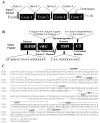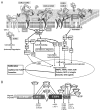Molecular control of vascular development by the matricellular proteins CCN1 (Cyr61) and CCN2 (CTGF)
- PMID: 24748747
- PMCID: PMC3989895
Molecular control of vascular development by the matricellular proteins CCN1 (Cyr61) and CCN2 (CTGF)
Abstract
The circulatory system is the first hierarchically ordered network to form during the development of vertebrates as it is an indispensable means of adequate oxygen and nutrient delivery to developing organs. During the initial phase of vascular development, endothelial lineage-committed cells differentiate, migrate, and coalesce to form the central large axial vessels and their branches. The subsequent phase of vessel expansion (i.e., angiogenesis) involves a cascade of events including endothelial cell migration, proliferation, formation of an immature capillary structure, recruitment of mural cells and deposition of a basement membrane to yield a functional vasculature. These series of events are tightly regulated by the coordinated expression of several angiogenic, morphogenic and guidance factors. The extracellular matrix (ECM) is synthesized and secreted by embryonic cells at the earliest stages of development and forms a pericellular network of bioactive stimulatory and inhibitory angiogenesis regulatory factors. Here we describe the role of a subset of inducible immediate-early gene-encoded, ECM-associated integrin- and heparin-binding proteins referred to as CCN1 (or Cyr61) and CCN2 (or CTGF) and their function in the development of the vascular system. Gene-targeting experiments in mice have identified CCN1 and CCN2 as critical rate-limiting determinants of endothelial cell differentiation and quiescence, mural cell recruitment and basement membrane formation during embryonic vascular development. Emphasis will be placed on the regulation and function of these molecules and their contextual mode of action during vascular development. Further understanding of the mechanisms of CCN1- and CCN2-mediated blood vessel expansion and remodeling would enhance the prospects that these molecules provide for the development of new treatments for vascular diseases.
Keywords: CCN1; CCN2; angiogenesis; blood vessels; development; extracellular matrix.
Conflict of interest statement
The author has no conflict of interest to disclose.
Figures


References
Grants and funding
LinkOut - more resources
Full Text Sources
Other Literature Sources
Miscellaneous
